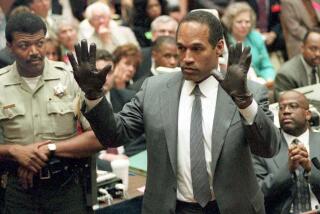First on the Scene in Stuart Murder Case : Television: ‘Rescue 911’ camera crew’s exclusive footage of the Boston shooting will air on the show tonight.
The camera crew had spent two nights riding around with the supervisor of the Boston Emergency Medical Service, looking for a traumatic injury that they could follow from the scene of an accident through surgery to make a compelling story for CBS’ “Rescue 911.” Nothing much had turned up. “We were shooting blanks,” cameraman Mike Parker recalled.
On the third night, about 8 p.m. last Oct. 23, they were headed toward a reported fire-bombed house when they heard a call over the medical frequency radio about a shooting in a car. “We took off on a 10-minute ride at top speed, with sirens going, not knowing the exact location,” Parker said.
They found it, and their compelling story. But they wouldn’t know for several months just how compelling it was.
Using his car phone, Charles Stuart had called the police to report that he and his pregnant wife, Carol, had been shot by a black man. Stuart was rushed to the hospital, the “Rescue 911” camera team in tow. His wife and child (delivered by emergency Caesarean) subsequently died, and an arrest was made. But in January, Stuart learned that he had become a suspect and leaped to his death from a bridge over the Mystic River, police said.
The footage that Parker shot that night will be shown on “Rescue 911” at 8 tonight in a 21-minute segment. Although a portion of it has been seen previously on news reports about the Stuart case, most of it is being broadcast for the first time.
Executive producer Arnold Shapiro said that “Rescue 911” hasn’t shown its exclusive material until now because the producers initially were waiting for Stuart to recover for a follow-up interview. After he killed himself, they had to go back to Boston to gather additional material, Shapiro said.
Parker, 42, a veteran photo-journalist who has worked for stations in Miami, Atlanta, Philadelphia and Pittsburgh, recalls the events of that night vividly. A free-lance cameraman working out of Los Angeles and Kansas City, Mo., he was teamed with sound man Tom Wolford and director Robin Groth. They arrived at the scene along with several police cars.
“We connected our umbilical cable (which attaches the sound equipment to the camera) and started shooting,” he said in an interview. “I could see that Carol Stuart was seriously injured. She had blood all over her and was unconscious, slumped in the car. She looked close to death. I started shooting her but the cops tried to push us out of the way. The director wanted us to shoot Chuck Stuart and the cops kept telling us to move.”
“The cops have a less-than-fairy-tale relationship with the media in Boston and I tried to explain we were with ‘Rescue 911.’ They didn’t really want to hear it. I was (angry). And that created a certain irony, because later they wanted our tape and said they wish I had gotten closer,” Parker said.
The local television stations had arrived by that time, which added to the clamor, Parker said. But he had a “hot” wireless microphone on the supervisor who was attending Stuart in the ambulance. “We actually got to the hospital ahead of the ambulance,” he said. He photographed Stuart being taken into the trauma room and later in the operating room.
“He was conscious in the trauma room, which was amazing because he had a .38 pistol wound in his abdomen,” Parker said. “He was coherent and I remember him inquiring about his wife and wanting to know her condition. Little did I understand the full implications of that at the time.”
Boston police were doing some digging of their own throughout Stuart’s surgery. And about four hours into the operation, they wanted to talk to Parker. They wanted to look at his tapes.
“The Boston cops dragged us out and took us to the station to look at the tapes which they had tried so hard to obstruct us from shooting,” Parker said. “We are not a news show, we’re entertainment; therefore we don’t have the same protection of the First Amendment as a news show. At the same time, it appeared to be such a heinous crime--the abduction and shooting--that we wanted to do everything we could to help the police find the perpetrator,” Parker said. They left the police with a dub of the tapes.
“The last time I saw Chuck Stuart, he was under general anesthesia with a group of doctors fighting for his life,” Parker said.
Aware that some people wonder if there wasn’t a clue somewhere initially that Stuart had actually done the shooting as part of his scheme to collect insurance money on his wife, the cameraman asked, “Why would you have been suspicious of a man having a supposedly perfect marriage, going to Lamaze classes with his wife?”
“That he took her to a deserted section and blew her brains out, killing her, killing their unborn child and shooting himself in the gut and almost dying from that, was not something anybody was thinking of,” Parker said.
The case also provoked charges of racial bias on the part of the media for the way they played up the story of a white couple supposedly being shot by a black man. “The story received the widespread publicity it did because it was a great story. Had the situation been reversed--a young, upscale black couple in a white Boston suburb shot and killed--it would have gotten the same coverage,” Parker maintained. “Remember Howard Beach, remember Tawana Brawley?”
Parker was returning to Kansas City from another story in January when he learned of Stuart’s role in the killings and his suicide. “I was absolutely stunned, and I’m not someone who is easily stunned. I’ve been in TV news for 20 years. There are not too many things that surprise or shock me. But this flat blew me away. We’d been had.”
Producer Shapiro was equally shocked. “For the rest of my life, I will try to figure out what makes sociopaths tick. The behavior defies my sense of logic and morality.” He is developing a TV movie about the case for CBS.
“In all these years of shooting local and network news,” Parker said, “this is the one story I’ll never forget. If I was the least bit naive about anything before, this ended it.”
More to Read
The complete guide to home viewing
Get Screen Gab for everything about the TV shows and streaming movies everyone’s talking about.
You may occasionally receive promotional content from the Los Angeles Times.






